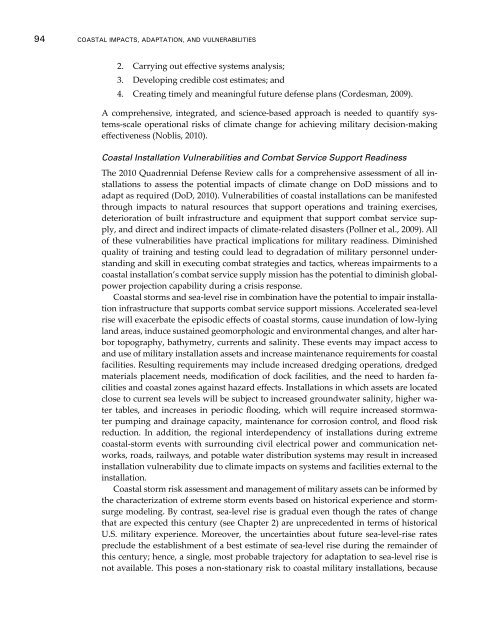Coastal Impacts, Adaptation, and Vulnerabilities - Climate ...
Coastal Impacts, Adaptation, and Vulnerabilities - Climate ...
Coastal Impacts, Adaptation, and Vulnerabilities - Climate ...
Create successful ePaper yourself
Turn your PDF publications into a flip-book with our unique Google optimized e-Paper software.
94 <strong>Coastal</strong> <strong>Impacts</strong>, <strong>Adaptation</strong>, <strong>and</strong> <strong>Vulnerabilities</strong>2. Carrying out effective systems analysis;3. Developing credible cost estimates; <strong>and</strong>4. Creating timely <strong>and</strong> meaningful future defense plans (Cordesman, 2009).A comprehensive, integrated, <strong>and</strong> science-based approach is needed to quantify systems-scaleoperational risks of climate change for achieving military decision-makingeffectiveness (Noblis, 2010).<strong>Coastal</strong> Installation <strong>Vulnerabilities</strong> <strong>and</strong> Combat Service Support ReadinessThe 2010 Quadrennial Defense Review calls for a comprehensive assessment of all installationsto assess the potential impacts of climate change on DoD missions <strong>and</strong> toadapt as required (DoD, 2010). <strong>Vulnerabilities</strong> of coastal installations can be manifestedthrough impacts to natural resources that support operations <strong>and</strong> training exercises,deterioration of built infrastructure <strong>and</strong> equipment that support combat service supply,<strong>and</strong> direct <strong>and</strong> indirect impacts of climate-related disasters (Pollner et al., 2009). Allof these vulnerabilities have practical implications for military readiness. Diminishedquality of training <strong>and</strong> testing could lead to degradation of military personnel underst<strong>and</strong>ing<strong>and</strong> skill in executing combat strategies <strong>and</strong> tactics, whereas impairments to acoastal installation’s combat service supply mission has the potential to diminish globalpowerprojection capability during a crisis response.<strong>Coastal</strong> storms <strong>and</strong> sea-level rise in combination have the potential to impair installationinfrastructure that supports combat service support missions. Accelerated sea-levelrise will exacerbate the episodic effects of coastal storms, cause inundation of low-lyingl<strong>and</strong> areas, induce sustained geomorphologic <strong>and</strong> environmental changes, <strong>and</strong> alter harbortopography, bathymetry, currents <strong>and</strong> salinity. These events may impact access to<strong>and</strong> use of military installation assets <strong>and</strong> increase maintenance requirements for coastalfacilities. Resulting requirements may include increased dredging operations, dredgedmaterials placement needs, modification of dock facilities, <strong>and</strong> the need to harden facilities<strong>and</strong> coastal zones against hazard effects. Installations in which assets are locatedclose to current sea levels will be subject to increased groundwater salinity, higher watertables, <strong>and</strong> increases in periodic flooding, which will require increased stormwaterpumping <strong>and</strong> drainage capacity, maintenance for corrosion control, <strong>and</strong> flood riskreduction. In addition, the regional interdependency of installations during extremecoastal-storm events with surrounding civil electrical power <strong>and</strong> communication networks,roads, railways, <strong>and</strong> potable water distribution systems may result in increasedinstallation vulnerability due to climate impacts on systems <strong>and</strong> facilities external to theinstallation.<strong>Coastal</strong> storm risk assessment <strong>and</strong> management of military assets can be informed bythe characterization of extreme storm events based on historical experience <strong>and</strong> stormsurgemodeling. By contrast, sea-level rise is gradual even though the rates of changethat are expected this century (see Chapter 2) are unprecedented in terms of historicalU.S. military experience. Moreover, the uncertainties about future sea-level-rise ratespreclude the establishment of a best estimate of sea-level rise during the remainder ofthis century; hence, a single, most probable trajectory for adaptation to sea-level rise isnot available. This poses a non-stationary risk to coastal military installations, because
















